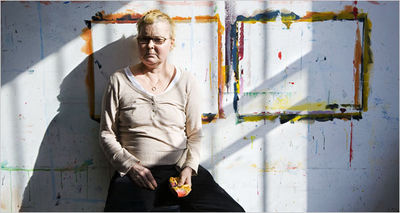 Painter Cordula Volkening died on Wednesday of brain cancer. A memorial is being planned. She is survived by two children ages 13 and 17.
Painter Cordula Volkening died on Wednesday of brain cancer. A memorial is being planned. She is survived by two children ages 13 and 17.
There was an article about Cordula Volkening in the New York Times a few months ago alongside this photograph by J.B. Reed and a video called "A Paintbrush and Nothing to Lose."
More
than a year ago, I got an email from a friend, who was Cordula's neighbor. She told me that Cordula, a visual artist, had been diagnosed with stage 4 brain cancer.
Doctors told her she had three months to live.
What
sounded like a terrible tragedy was actually a life affirming story of
art triumphing over adversity. Despite the cancer, Cordula devoted herself to her wild, expressionistic paintings; she seemed to have an
incredibly passionate attitude about the end of her life and what she wanted to accomplish.
For obvious reasons, I included her on the Park Slope 100 for being an inspiring artist and person.
Here's her Park Slope 100 blurb:
Cordula Volkening because with a diagnosis of stage 4 brain
cancer you decided to quit your job and devote yourself to your
painting. "Hey, I got advanced brain cancer – my system kicks me in the
butt and screams: Be your authentic self or you are going to die sooner
not later. Any questions?"
I wrote about her again in June 2008 because she was having a show
called Would You Like an Invitation to My Destination? at the Brooklyn Artists Gym.
At the time I wrote:
Cordula is real hero in my
book, a wild, brave heart, for not letting her disease get in the way
of her desire to make paintings. Sadly, the tumor makes it impossible
for her to speak.
Cordula underwent two rounds of brain surgery and was in an
experimental clinical trial. The tumor impaired her ability to
speak, but it did not keep her from making great art.The following is from the Times:
Ms. Volkening even tried a special experimental study at NewYork-Presbyterian/Weill Cornell
hospital, which involved spending her days with electrodes attached to
her head. But by last March, the tumor was back and doctors operated
again, which damaged her speech capacity, and last September, doctors
found a second, inoperable tumor and said that heavy chemotherapy could
give her a few more months but probably would leave her without the
energy to paint.
Reading the article, I was heartened by the fact that she was still alive—and that she was still painting. After all, doctors told her she only had three months to live. Cordula had other ideas.
